Sydney Sweeney’s American Eagle Ad: The Outrage and Celebration
In the ever-evolving world of fashion advertising and celebrity endorsements, no one has made quite a splash quite like Sydney Sweeney in her latest campaign for American Eagle. Sweeney, who has gained immense popularity through her roles in hit series like “Euphoria” and “The White Lotus,” is now generating buzz that transcends mere styling. Her association with American Eagle has ignited a fascinating mix of outrage and applause, showcasing the complexities of woke advertising and the influence of social media on market trends.
The Buzz begins
When Sydney Sweeney appeared in American Eagle’s latest ad, it was expected that her star power would draw attention. What nobody anticipated was the flood of reactions that would follow. Critics quickly labeled the advertisement as ‘woke’, sparking a firestorm across social media platforms. The term ‘woke’ has become a polarizing catchword often used to describe agendas perceived as excessively progressive or political.
The ad, which featured Sweeney donning chic American Eagle apparel, sparked backlash among parts of the internet that viewed it as yet another example of brands pushing a progressive narrative. However, what transpired was even more interesting: a significant proportion of fans celebrated Sweeney’s approach—defending the artist and proclaiming her to be at the forefront of a new wave of advertising.
Outrage and Praise: A Double-Edged Sword
The initial outrage stemmed from the advertisement’s portrayal of body positivity and inclusivity, elements which are often at the very core of today’s marketing strategies. Critics claimed these messages were just thinly veiled attempts at virtue signaling, accused brands like American Eagle of peddling ‘woke capitalism.’ For them, the focus on societal issues, particularly those related to race, gender, and identity, in commercial spaces felt disingenuous and forced.
On the flip side, Sweeney’s defenders praised her authenticity, arguing that positive representation in advertising is overdue. Through thriving social media channels, supporters cheered her for “killing woke advertising” and diverting the conversation into a more inclusive realm. The meme culture that spread from this campaign turned Sweeney into an iconic symbol, further feeding her popularity and solidifying her status among younger demographics.
Sydney Sweeney: Meme Stock Icon
It’s important to note that the reaction towards Sweeney’s collaboration with American Eagle has fueled a unique phenomenon—transforming her into a meme stock icon. This evolution captures the interplay between modern advertising, social movements, and stock market implications. Shortly after the advertisement’s launch, American Eagle’s stock price began to rise, suggesting that the campaign successfully piqued consumer interest and possibly created a new trend.
The meme stock rally is reminiscent of occurrences in the past when celebrities like Elon Musk have sparked significant interest in particular stocks through social media presence. Sweeney’s influence appears to be leveraged in a similar fashion. Her rise as the face of American Eagle is not just a fashion statement; it is also shaping market sentiments. Investors are keenly aware of how celebrity culture influences consumer behavior, establishing a narrative where the ad isn’t just a transaction—a cultural movement.
The Broader Implications for Advertising
The culture surrounding advertising is shifting substantively. Brands are pressed to align their missions with the values of their target audience. The connection fans feel towards stars like Sydney Sweeney creates an avenue for deeper consumer intimacy, enabling brands to engage with their audiences in a more meaningful way. Yet, this also comes with challenges. The rising expectation for authenticity means that brands risk backlash if consumers perceive a disconnect between the icon and the brand’s message.
It begs the question: what happens when the desire for inclusive marketing meets backlash from those who feel overwhelmed by its prevalence? That’s a discussion we’re witnessing in real-time as various platforms provide a stage for both supporters and detractors to voice their opinions.
Consumer Behavior in the Age of Meme Culture
Furthermore, the intertwining of consumer behavior and meme culture adds layers of complexity to traditional marketing strategies. The rapid pace and spread of the meme have empowered audiences to transcend passive reception, allowing them to dictate narratives through social interactions. As followers on platforms like Twitter and TikTok continue to remix and repost advertisements, brands must learn to tread carefully, balancing between visionary messaging and avoiding a backlash.
The sheer volume of memes generated around Sweeney’s advertisement highlights consumer sentiment—and it isn’t merely about the advertisement itself. Instead, it speaks broadly to the desire for a cultural environment where creativity, inclusivity, and genuine connection coexist without triggering outrage. It’s this type of engagement that fuels viral trends and, in this case, substantially influences the stock market.
What’s Next for Sydney Sweeney?
As the dust settles on the storm surrounding the American Eagle advertisement, the question remains: what lies ahead for Sydney Sweeney? She finds herself not just as an actress but as a cultural icon that has sparked conversation around complex themes of marketing, activism, and consumer dynamics. It’s crucial to monitor how both she and American Eagle navigate the murky waters of modern advertising moving forward.
Ultimately, no matter where one stands in terms of the backlash or the praise for the advertisement, it underscores a significant truth of our time: advertising, when wielded thoughtfully, can be an impactful tool for societal change. Sweeney’s situation exemplifies this intersection of fashion and activism, advertising, and authenticity—all while riding the waves of meme culture.
Conclusion
Sydney Sweeney’s American Eagle ad has encapsulated the broader conversation surrounding modern advertising’s relationship with woke culture, activism, and, crucially, consumer response. Whether for better or worse, she has become a leading figure in a campaign that sparked outrage yet also empowered many to celebrate inclusivity. As we continue to dissect the implications, one thing is clear: both the fashion world and its cultural contexts are on the brink of significant transformation, propelled by icons like Sweeney and the meme culture surrounding them.







